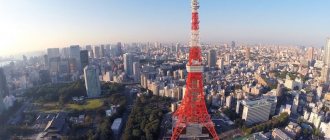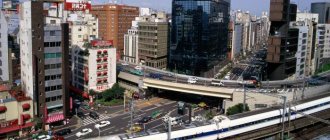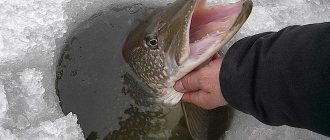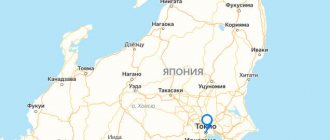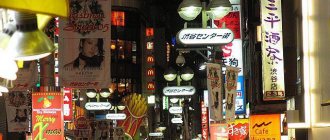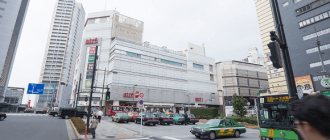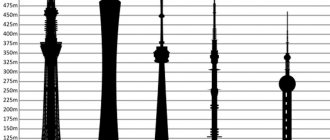Climatic features
You can fly to the Far East at any time of the year. The country stretches from north to south, and the weather in Japan is determined by four climatic zones:
- moderately cold (Hokkaido);
- moderately warm (Honshu Island);
- subtropics (Kyushu Island and the north of the Ryukyu archipelago);
- tropics in the southern part of Ryukyu.
On the islands there are clearly distinguished 4 seasons and 2 rainy periods.
The island of Hokkaido is considered the pole of cold. In winter, snowstorms rage here, cold Siberian winds blow, heavy snowfalls cover the mountains with two-meter snowdrifts. The lowest temperature recorded was 41° below zero. But such cataclysms happen rarely. Typically, winter cold stays at 8.5° below zero. It is much warmer on the island of Honshu. Snow falls here too, but it melts quickly.
Cold air masses are replaced by a series of cyclones and anticyclones. After the rains, clear weather sets in. Sakura begins to bloom from the beginning of March . Next the plum blossoms, followed by azalea and wisteria, and for a whole month crowds of tourists contemplate the colorful blossoms, which begin in the south of the country and gradually reach the northern regions. But sooner or later the flowers fall off and the weather deteriorates.
The rainy season in Japan starts from the southern shores, gradually moving north, without affecting the island of Hokkaido. The wet period begins with a light drizzle and ends with water squalls, hours-long downpours with landslides. Meanwhile, hot winds from the tropical Pacific bring heat and high humidity. The temperature in some places rises to 38-40°. The rains are receding, but high humidity makes traveling around the country uncomfortable. The exception is hiking in the mountains, where it is a little cooler.
At the beginning of autumn, the country is again in a fever; the season of typhoons and hurricanes is approaching. And only in October does nature calm down and, as compensation, gives the Momiji season - a period when lush greenery gives way to bright crimson. If you missed the cherry blossoms, come admire the red and yellow maples.
© trevor_dobson_inefekt69 / flickr.com / CC BY 2.0
Climate of Japan
What is the best time to travel to Japan?
When you go on vacation, it is very important to know what the climate and weather are like during your trip. The climate in Japan varies greatly from north to south, so some preparation is required.
Fortunately, most of Japan has a temperate maritime climate, with warm summers and fairly mild winters.
Most travelers will head to the eastern areas, such as the two large islands of Honshu and Hokkaido. Here you will have to deal with a cool or temperate continental climate. Sea water here has less influence on temperature and precipitation, because the areas are often closed from the Pacific Ocean by various mountain spurs.
Of the Ryukyu Islands, the southernmost islands, the Okinawa Islands, even have a subtropical climate. Temperatures here are usually around 20 degrees during the winter months.
The figure below shows the temperature in different cities in Japan.
If you want to know exactly what the best time to visit each city is, you will find below some climate tables of cities throughout Japan.
CONTENT
Climate of Japan: seasons
Japan has four seasons almost everywhere in the country, with the exception of the south (around Okinawa), which has a subtropical climate. Transitions between seasons happen faster than ours.
Night frosts can occur in early March, and a month later in April it is already hot.
TYPICAL JAPAN
In Japan, winter lasts on average from December to March, spring from April to mid-May. Summer begins in mid-May and lasts until the end of September. Autumn months are October and November. This means longer summers and shorter winters.
Below you will find several climate tables for Japan and the cities of Tokyo, Kyoto, Sapporo and Naha (Okinawa).
Climate graph Japan
| month | average maximum temperature (°C) | average minimum temperature (°C) | average number of sunshine hours per day | average number of days of precipitation per month | average mm of precipitation per month |
| January | 11 | 0 | 7 | 9 | 31-60 mm |
| February | 10 | 1 | 6 | 11 | 31-60 mm |
| March | 13 | 4 | 5 | 17 | 61-100 mm |
| April | 19 | 9 | 5 | 17 | 101-200 mm |
| May | 23 | 14 | 6 | 16 | 101-200 mm |
| June | 25 | 18 | 4 | 22 | 101-200 mm |
| July | 29 | 22 | 5 | 21 | 101-200 mm |
| August | 31 | 24 | 6 | 17 | 101-200 mm |
| September | 27 | 20 | 4 | 20 | 101-200 mm |
| October | 21 | 14 | 5 | 17 | 101-200 mm |
| november | 17 | 8 | 5 | 12 | 61-100 mm |
| December | 13 | 3 | 6 | 9 | 31-60 mm |
Climate graph of Tokyo (Honshu)
| month | average maximum temperature (°C) | average minimum temperature (°C) | average number of sunshine hours per day | average number of days of precipitation per month | average mm of precipitation per month |
| January | 11 | 0 | 6 | 9 | 31-60 mm |
| February | 10 | 2 | 6 | 11 | 31-60 mm |
| March | 13 | 4 | 6 | 19 | 61-100 mm |
| April | 19 | 9 | 5 | 16 | 101-200 mm |
| May | 23 | 14 | 6 | 16 | 101-200 mm |
| June | 26 | 18 | 4 | 20 | 101-200 mm |
| July | 29 | 22 | 5 | 21 | 101-200 mm |
| August | 31 | 25 | 6 | 17 | 101-200 mm |
| September | 27 | 20 | 4 | 20 | 200++ mm |
| October | 21 | 15 | 4 | 17 | 101-200 mm |
| november | 17 | 8 | 5 | 12 | 61-100 mm |
| December | 12 | 3 | 6 | 10 | 31-60 mm |
Climate graph of Kyoto (Honshu)
| month | average maximum temperature (°C) | average minimum temperature (°C) | average number of sunshine hours per day | average number of days of precipitation per month | average mm of precipitation per month |
| January | 9 | 2 | 5 | 19 | 31-60 mm |
| February | 10 | 3 | 5 | 19 | 31-60 mm |
| March | 14 | 4 | 5 | 20 | 61-100 mm |
| April | 21 | 10 | 6 | 17 | 101-200 mm |
| May | 25 | 14 | 6 | 15 | 101-200 mm |
| June | 27 | 19 | 5 | 18 | 200++ mm |
| July | 30 | 23 | 6 | 19 | 101-200 mm |
| August | 33 | 24 | 7 | 17 | 200++ mm |
| September | 28 | 19 | 5 | 18 | 101-200 mm |
| October | 23 | 13 | 5 | 14 | 101-200 mm |
| november | 17 | 8 | 5 | 15 | 61-100 mm |
| December | 12 | 4 | 5 | 10 | 31-60 mm |
Climate graph of Sapporo (Hokkaido)
| month | average maximum temperature (°C) | average minimum temperature (°C) | average number of sunshine hours per day | average number of days of precipitation per month | average mm of precipitation per month |
| January | -2 | -9 | 3 | 29 | 101-200 mm |
| February | -1 | -8 | 4 | 24 | 61-100 mm |
| March | 3 | -3 | 5 | 25 | 61-100 mm |
| April | 11 | 2 | 6 | 20 | 61-100 mm |
| March | 17 | 8 | 6 | 18 | 61-100 mm |
| June | 22 | 12 | 6 | 17 | 61-100 mm |
| July | 25 | 17 | 5 | 17 | 101-200 mm |
| August | 26 | 19 | 5 | 19 | 101-200 mm |
| September | 22 | 13 | 6 | 18 | 101-200 mm |
| October | 15 | 6 | 5 | 20 | 101-200 mm |
| november | 8 | 1 | 3 | 25 | 101-200 mm |
| December | 1 | -5 | 3 | 28 | 101-200 mm |
Climate graph of Naha (Okinawa)
| month | average maximum temperature (°C) | average minimum temperature (°C) | average number of sunshine hours per day | average number of days of precipitation per month | average mm of precipitation per month |
| January | 19 | 14 | 3 | 21 | 101-200 mm |
| February | 20 | 15 | 3 | 19 | 101-200 mm |
| March | 21 | 16 | 4 | 20 | 101-200 mm |
| April | 24 | 19 | 5 | 18 | 101-200 mm |
| May | 27 | 21 | 5 | 19 | 200++ mm |
| June | 29 | 24 | 6 | 19 | 200++ mm |
| July | 31 | 26 | 8 | 19 | 101-200 mm |
| August | 31 | 26 | 7 | 22 | 200++ mm |
| September | 30 | 25 | 7 | 19 | 101-200 mm |
| October | 27 | 22 | 6 | 19 | 101-200 mm |
| november | 24 | 18 | 4 | 19 | 101-200 mm |
| December | 21 | 15 | 4 | 21 | 101-200 mm |
Elevation changes affect the weather
The "lonely schoolgirl" train station is finally closing. Q-Shirataki Japan.
Japan has large elevation changes due to volcanoes and mountain ranges on the islands. Some examples are the Japanese Alps (Nihon Arupusu), which consists of the Hida, Kiso and Akaishi mountains. The highest mountain or actually volcano in Japan is 3776 meters high and is called Fuji.
Just below Mount Ainodake is 3189 meters, and Kitadake is 3193 meters. Due to the different altitudes, the difference in weather is great. Mountains often block the clouds, so one place gets a lot of rain while another gets little to no rain. As a result, Japan has a highly variable climate where you can experience different types of weather close to each other. Especially in mountainous areas you suffer from this changeable weather.
Summer temperatures due to low latitude
Summer in Japan can be described as warm or very warm. This is because Japan has a relatively low latitude. For example; The northernmost island of Hokkaido is on the same level as Barcelona. Northern Japan is hot in the summer, but central and southern Japan around the islands of Shikoku and Kyushu are very hot.
In summer, big cities like Tokyo, Kyoto or Hiroshima can often be very stuffy and humid due to clouds. If you're really looking for sun, sea and beach in Japan, then fly to Okinawa. These islands are subtropical and usually have good weather even in winter.
The dumbest cafe robbery in 2021. Japan
Rain and snow in Japan
It can rain heavily in Japan, like in Africa, and this happens throughout the year. This rain is distributed throughout Japan, but it rains the most during the summer months, which can reach up to 300 mm or more per month. The north receives an average of 1000 mm of precipitation per year, which is significantly less than the south. Take for example the island of Hachijima, which receives about 3100 mm of precipitation per year (located south of the island of Honshu).
During the winter months, precipitation may also fall in the form of snow. The chance of snowfall is high on the islands of Hokkaido and Honshu, especially in mountainous areas. Due to the large amount of snow in Japan, you can go skiing or snowboarding. The Japanese population also loves winter sports, but unfortunately it is very expensive and accessible to few.
The weather data on this page has been carefully collected from meteorological sources such as Japanese government data.
Castles of Japan. Samurai ancestral nests
Views: 1,861
Share link:
- Tweet
- Share posts on Tumblr
- Telegram
- More
- by email
- Seal
Liked this:
Like
Similar
Where to go
Winter landscapes in Japan are rather boring: wet snow melts quickly, turning into slush, the trees are bare, and it gets dark early. But you can go to the ski resorts of Hokkaido and spend several unforgettable days here.
If you're on Honshu in April or May, when Japan's wisteria blooms, visit Ashikaga Flower Park and walk through the Tunnel of Love. Blooming vines can be compared to a fairy-tale waterfall, and delicate purple inflorescences look like butterflies.
Kyushu Island and the southern tip of Honshu are located in the subtropical zone. There is practically no winter here; summer is hot and very humid. It is better to go here in the cool autumn. The heat is subsiding, beach holidays are in full swing, the season continues until November. You can go on excursions to ancient temples and monasteries.
To the south, on the Ryukyu Island, the tropical zone begins. It's summer here all year round, but the heat is moderated by the fresh sea breeze, and tourists from all over the country come to relax on the beaches of Okinawa.
The rainy season, which begins its journey from the southern shores in May and comes to the north in June, can ruin your vacation. It lasts about two months. Even when there is no precipitation, the sky is covered with low, gloomy clouds. But hydrangea is blooming, trips to hot springs and tours to the most beautiful places in the country are organized. Prices are falling, the flow of tourists is drying up, excursions are becoming cheaper.
To decide when is the best time to go to Japan, consider the weather at different times of the year by month.
© Hetarllen_Mumriken / flickr.com / CC BY 2.0
Weather in Tokyo by months (table)
Below is the table of weather in Tokyo by month. In the table you will find such climate parameters in the city of Tokyo, such as the average temperature in the city of Tokyo by month
, average humidity in Tokyo city by month, average wind speed in Tokyo city by month,
number of sunny days in Tokyo city
by month,
number of rainy days in Tokyo city
by month and other information.
Let us know if this table is useful to you? Useful table (3620) No (638)
| Month | average temperature | Average humidity | Wind speed | Amount of days | ||||
| Clear | Cloudy | Mainly cloudy | Rain | Snow | ||||
| January | +6.2°С | 54 % | 3.8 m/s | 14 | 13 | 2 | 0 | 0 |
| February | +7.2°С | 56 % | 4.3 m/s | 12 | 14 | 3 | 1 | 0 |
| March | +10.7°С | 61 % | 4.5 m/s | 11 | 15 | 3 | 1 | 0 |
| April | +14.8°С | 66 % | 4.3 m/s | 10 | 15 | 4 | 1 | 0 |
| May | +19.8°С | 70 % | 4.5 m/s | 10 | 17 | 2 | 1 | 0 |
| June | +22.5°С | 78 % | 3.7 m/s | 4 | 22 | 3 | 0 | 0 |
| July | +25.8°С | 84 % | 3.7 m/s | 3 | 23 | 4 | 0 | 0 |
| August | +27.5°С | 79 % | 4.2 m/s | 3 | 22 | 4 | 1 | 0 |
| September | +23.9°С | 80 % | 3.7 m/s | 5 | 16 | 6 | 2 | 0 |
| October | +18.8°С | 74 % | 3.8 m/s | 6 | 17 | 5 | 1 | 0 |
| November | +13.4°С | 68 % | 3.5 m/s | 9 | 16 | 4 | 1 | 0 |
| December | +8.3°С | 58 % | 3.7 m/s | 13 | 14 | 3 | 0 | 0 |
The magic of spring
Most tourists come to Japan in the spring, when the cherry blossom season begins. On the island of Okinawa, spring arrives in January, gradually moving north. When sakura blooms, there is an influx of tourists in Japan. If you don't pay attention to the crowds and high prices, spring in Japan is the best holiday season. Competition comes in the fall, when the foliage turns yellow and purple and maples begin to bloom.
In March, prices for air tickets, hotels, and excursions jump. But this does not frighten tourists who have traveled vast distances to see the cherry blossoms with their own eyes. Warm, clear weather sets in. And only on the coast of the Sea of Okhotsk the cold wind brings thick fog and frost. The air temperature in Tokyo is 14°, in Ryukyu and Okinawa – 21°.
In April, spring comes to Kyoto and Tokyo. The thermometer in the capital rises to 17°, in the southern resorts to 22°. The weather is sunny, cherries, plums, and apricots are blooming in parks and gardens. Throughout the country there is a Hanami holiday - admiring flowers. Other festivals in Japan will also start in the spring. These are temple festivals, a national dance competition in Tokyo. At the end of the month, Golden Week opens, when a series of significant dates :
- Seva Day – April 29;
- Constitution Day – May 3;
- Green Day – May 4;
- Children's Day – May 5th.
The Japanese move around the country en masse, merging with the flow of tourists. As a result, there is a shortage of hotel rooms, expensive tickets, and traffic jams.
But the weather in May is comfortable for traveling around the country: in Tokyo 20-22°, in the northern districts an average of 17°. On the Ryukyu Islands and Okinawa, the holiday season is in full swing, with temperatures rising to 30°. The rains begin only in the last ten days of May.
© 453277 / pxhere.com / CC BY 2.0
General information about the weather in Tokyo (climate in Tokyo)
| Content |
| –> Current month |
| –> The warmest, coldest, sunny and snowy |
| –> Weather by month (table) |
| –> Temperature by month (graph) |
| –> Humidity by month (graph) |
| –> Wind rose |
The site contains information about the weather in the city of Tokyo since 2014. This page tells about the weather in Tokyo
in general, that is, about
the climate in the city of Tokyo
.
More detailed weather data in Tokyo
can be obtained, for example, from the following links:
- Weather in Tokyo in July,
- Weather in Tokyo in July 2021,
- Weather forecast in Tokyo
Each page contains detailed information about temperature, humidity, wind rose in the city of Tokyo
and other climate parameters in the corresponding month. Another city and another date can be selected in the site menu.
Hot Summer
In June, the country is flooded with rain, and the air warms up to 30°. Very stuffy, damp and cloudy. Fleeing from natural disasters, tourists flock to Hokkaido, where May is still raging, irises and lotuses are blooming.
In July, the plum rains begin to subside, but the sweltering heat combined with high humidity are not the best conditions for travel. But for this period the cheapest tickets are sold. From July 1 to August 27, climbing the sacred Mount Fuji is officially permitted.
In August, the heat subsides slightly, but high humidity remains. Try to get to the island of Honshu by August 8, when the fireworks festival in Japan attracts hundreds of thousands of tourists, and the sky over Lake Biwa lights up with fiery colors and fancy hieroglyphs.
The Buddhist festival of Obon is celebrated in the middle of the month . The Japanese remember the souls of their departed ancestors. People are being released from work so they can visit their homes. Tourists need to be prepared for crowds of people, queues, and lack of room in hotels.
© oadtz / pixabay.com / CC BY 2.0
Such a different autumn
In September, hurricanes and typhoons come along with the long-awaited coolness. Although during the day the temperature sometimes rises to 30°, at night it is cold – up to 10°. Chrysanthemums are blooming, and on this occasion the Japanese are organizing another flower festival.
In October, the weather is calm and cool, and nature delights with its bright colors. Maple season in Japan is the best time to travel around the country. In Tokyo during the day it is 20-22°, in Okinawa 27°.
In November, golden autumn descends on the country. The air is clear and clean, there are frosts in the mornings, but the chrysanthemums have not yet bloomed. In the capital up to 16°, in the southern city of Naha up to 25°. There are few tourists, prices are reasonable.
© 618474 / pxhere.com / CC BY 2.0
Helpful advice
Save on housing by renting an apartment from a local on Airbnb. Get 2100 rub. as a gift for your first booking.
Best time to visit Tokyo
As they say, there is no arguing about tastes. But hardly anyone would like to run around the city in pouring rain. The best months to visit the capital of Japan are considered to be from March to May and from October to December. During these periods there is little precipitation and gentle temperatures. Moreover, the Japanese themselves say that it is better to come at the end of March and not plan to stay here longer than the first ten days of December. Otherwise you may end up in the cold. Please note that there is no central heating in the country!
Let's look at the merits of the seasons by month. In spring it is not yet hot, there is little rainfall. But the cherry blossoms are in bloom, and the gentle breeze from the ocean pleasantly invigorates. Snow-white petals swirl in the air like snowflakes until mid-April. Tokyo has many sunny days, delighting tourists and allowing them to admire local attractions. The Japanese also love this period.
In autumn, after the end of the rainy season, the city also becomes nice. The sweltering August heat is disappearing. The trees dress up in colorful autumn decorations. In November, sometimes the breath of winter can already be felt, but the warm weather persists for a long time. Please note that the most visited months for Tokyo are summer. There are a lot of tourists everywhere that you constantly have to deal with. This is not entirely convenient, especially in rainy times.
Winter's Tale
The average winter temperature ranges from 1° to 14° depending on the region.
In December, the country prepares for the New Year holidays. It is important for believers to know when Christmas is in Japan and how they celebrate it. To avoid conflicts, local churches received a special blessing, and Orthodox Christians celebrate Christmas together with Catholics on December 25th. For the Japanese who profess Buddhism and Shintoism, this is simply a beautiful, romantic evening with loved ones.
New Year is a favorite holiday in Japan, where modern culture mixes with ancient traditions. Snow lies only in the northern region. Therefore, in January, skiers go to the resorts of Hokkaido.
In February, spring returns to the islands, green grass emerges, buds swell, and Japanese cherry blossoms bloom in the south.
© tater65 / flickr.com / CC BY 2.0
Beach holidays in Japan
Russians do not consider Japan as a country for a beach holiday. To do this, choose resorts that are closer and cheaper. However, the holiday season in the southern archipelagos lasts all year round; the water temperature does not fall below 20°, and in the summer it rises to 27°. Seaside resorts are popular among native Japanese.
The main flow of tourists occurs in July and August. A fresh sea breeze makes it easier to endure heat and high humidity. But prices are high, and budget rooms are sold out long before the start of the season. Therefore, it makes sense to come here in other months.
General climatic conditions
The capital of Japan is located on the ocean, in the area of the warm Kuroshio Current. This causes increased climate humidity. The driest months are January and February. They are also the coldest. The climate in this area can be compared with the Black Sea coast of the Caucasus or Crimea. Temperatures rarely drop below zero. Although there is snow in Tokyo too. As a rule, it pleases the local population once a year.
This region has two rainy seasons. The first one falls at the beginning of summer. Approximately it runs from the first of June and ends in the second ten days of July. The Japanese joke that at this time people walk and swim at the same time. The second half of this month and the whole of August is a time of heat. It is preferred by many tourists to visit local attractions. The second wet season begins in September. According to official data, June and the first month of autumn have the fewest hours of sunshine (120 and 113, respectively).
